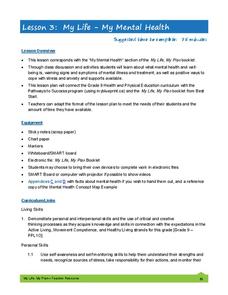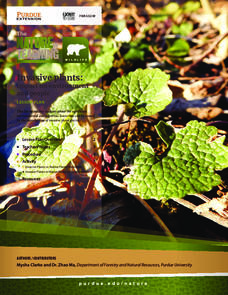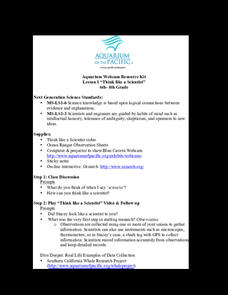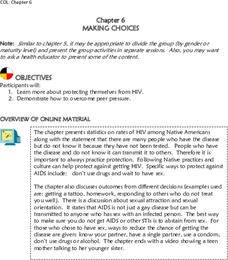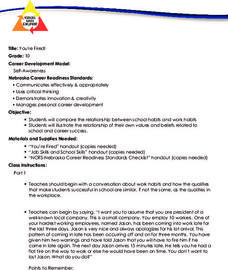EngageNY
Games of Chance and Expected Value 1
There's a strong chance that class members enjoy learning math through engaging games. Scholars analyze games of chance to determine long-term behavior. They learn to calculate expected value to help with this assessment.
Space Awareness
Water is a Heat Sink
One of the key objectives of Europe's Copernicus Earth program is to monitor the temperatures of the oceans and seas on Earth. Young scholars learn the effects of different heat capacities through two experiments. These experiments...
Florida International University
Counting FishStix
How do we count the fish in the ocean? An engaging lesson models how to estimate fish populations with observational surveys. Class members begin by studying the behavior of fish on the coral reef in the oceans. They then become the fish...
Cornell University
Light Waves: Grades 9-12
Explore the behavior of light waves with a lab activity. Scholars build new vocabulary through experimentation and observation. Using different mediums, they model reflection, refraction, transmission, diffusion, and scattering of light.
Hastings Prince Edward Public Health
My Life—My Mental Health
Between peer pressure, an onslaught of hormones, and brand new responsibilities, the teenage years can be emotionally volatile. Equip young adults with coping mechanisms and a safe place to discuss their feelings with a guided lesson...
Advocates for Youth
What Reduces Sexual Risks?
Teens don't have the ability to see around all of the corners of their decisions, some of which can affect the rest of their lives. Help them understand the implications of risky sexual behavior, including sexually transmitted diseases...
American Psychological Association
Research Ethics
Psychologists designing experiments to research human behavior must consider weighty ethical concerns. Class members act as members of an institutional review board and examine proposals to determine whether included provisions...
National Nanotechnology Infrastructure Network
Gelatin Microfluidics
Micro what? Analyze microfluidics as an application in the medical community. A lab investigation highlights the importance of channel design in biotechnology. Learners modify channels and observe the behavior of the flow of the fluids.
Kenan Fellows
Attack of the Aphids!
Insects threaten the food production industry, and aphids are one of the big players! Analyzing data of aphid populations gives insight into their behaviors. Learners model the population data of an uninhibited population with an...
Bully Free Systems
Bully Free Lesson Plans—Second Grade
Two lessons shed light on bullying in hopes to create a bully-free zone in your classroom. The first lesson defines bullying and allows scholars to reflect on their behavior. The second lesson focuses on choices and consequences. Both...
Purdue University
Invasive Plants: Impact on Environment and People
It's the attack of the invasive species! Young scientists simulate the behavior of an invasive species with a game-like activity. They assume the roles of native plants, invasive plants, and resources and watch the invasive plant takes...
Chicago Botanic Garden
Ecological Mismatches
Modeling is a powerful teaching tool. The final installment in a six-part series has pupils complete an activity to model a food web and discover the interconnected relationships in an ecosystem. They then read about changes in migratory...
Aquarium of the Pacific
Think Like a Scientist
Scholars watch a video and meet a scientist who is studying sharks as she explains her observations about the sharks and provides her hypothesis to explain their behavior. Learners then act like a scientist as they watch an aquarium...
Healthy Native Youth
Chapter 6: Making Choices
A lesson looks closely at risky behavior such as teen pregnancy and sexually transmitted diseases. Middle schoolers use a question box to ask questions anonymously. They role-play what life would be like if they became pregnant then...
C-SPAN
Supreme Court Justices Research and Resumes
According to Article III, Section1 of the United States constitution, the only qualification one needs to be appointed to the Supreme Court is to demonstrate "good behavior." The president and Congress are given the power to determine...
Nemours KidsHealth
Sportsmanship: Grades 9-12
The increasing number of unsportsmanlike conduct penalties, red cards, and ejections from games points out the need for activities that help young people recognize behaviors that exemplify good sportsmanship. For homework, class members...
Nemours KidsHealth
Online Safety: Grades 9-12
Teach teens how to protect themselves from hackers, scammers, and online predators. First, class members examine their own digital footprints think critically about their online profile. Groups then generate lists of "do" and "don't do"...
Roy Rosenzweig Center for History and New Media
George Washington: General, President, Slave Owner
Times change; behaviors that were once considered acceptable can be seen in a very different light. Middle schoolers revisit the legacy of George Washington in a three-day lesson plan that uses primary sources to reveal Washington as a...
American Chemical Society
Why Do Puddles Dry Up?
Bring evaporation right into the hands of young scientists with an entertaining, hands-on activity. Investigators view videos and images while participating in class dialogue focused on water evaporating from surfaces. A short experiment...
Health Smart Virginia
Cyber Tattoo
Sophomores use a website evaluation tool to determine if their selected websites are valid and reliable. They read about and list three behaviors about taking and sending photos of minors that qualify as Class 1 misdemeanors in their...
Health Smart Virginia
What's Up with Mindfulness
Mindfulness is all about paying attention to the present. Introduce freshmen to a stress-reducing tool that helps them pay close attention to what is happening, choose their behavior, and respond. Learners use a timeline to track their...
Health Smart Virginia
Caring School Environment Performance Task
In a school scenario, pupils stay home to keep from the teasing and bullying on campus. To combat unkind behavior, small groups survey learners in other grade levels, discuss and summarize their findings, then work together to create a...
Nebraska Department of Education
You're Fired!
Is willing to learn. Follows directions. Takes the initiative. The big idea in this career development lesson is that the work habits that make one successful in school are the same as those required to succeed in a career. Class members...
Overcoming Obstacles
Developing a Positive Attitude
The third lesson in the Goal Setting series looks at the impact of a positive attitude on achieving one's goals. Participants create and then share visuals that represent positive attitudes. They then brainstorm ways to develop positive...
Other popular searches
- Behaviorism Skits
- Behaviorism Theory
- Pink and Say Behaviorism
- Psychology Behaviorism
- Math Behaviorism
- Elementary Behaviorism
- Theories of Behaviorism
- Behaviorism Lesson Plans
- Multiplying Math Behaviorism
- Behaviorism Watson
- Behaviorism Theory Classroom






